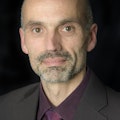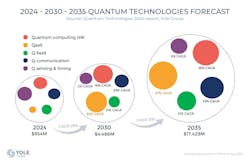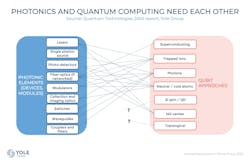Photonic powerhouse: Light is driving the quantum revolution
Photonics and lasers lie at the heart of the quantum computing revolution. They are indispensable tools that enable many of the most promising qubit platforms to function and scale toward practical machines that can tackle real-world problems. Building a useful quantum computer remains a monumental task. Engineers and physicists must contend with qubit noise, error-correction overhead, and the persistent challenge of scaling. Unlike classical bits, fragile quantum states can be disturbed by the slightest perturbations. As a result, researchers strive to maintain high fidelity and long coherence time, because most error-correcting methods demand two-qubit gate fidelities much above 99.9% to achieve fault tolerance.
At Yole Group, we’re closely monitoring and analyzing the evolution of quantum technologies. Our in-depth analyses, including the Quantum Technologies 2025 and Optical Computing 2024 reports, provide a clear understanding of this rapidly advancing field. Where does the technology stand today? What influence will quantum technologies exert on the photonics landscape? What are the most promising applications and who are the key players shaping this ecosystem?
In this snapshot, we provide a comprehensive overview of the quantum industry, highlighting the key developments and trends you need to know.
Qubit technologies
The various qubit technologies each offer distinct advantages and challenges, but many rely on lasers or other photonic devices. Cold-atom platforms, for example, confine neutral atoms within periodic arrangements known as optical lattices with lasers. These lattices arise from carefully arranged laser fields whose frequencies, intensities, and phases must be stabilized.
Trapped ions represent another leading modality in which individual atomic ions, often ytterbium, calcium, or beryllium, float within electromagnetic traps inside ultrahigh-vacuum chambers cooled to millikelvin (mK) temperatures. Laser light performs multiple roles: Doppler cooling brings ions to their motional ground state; resonant excitation initializes electronic spin states; Raman beams entangle qubits by coupling internal states to shared motional modes; and fluorescence from laser excitation serves as the readout mechanism, distinguishing quantum “0” from “1” based on scattered photons.
Superconducting circuits, which operate within the microwave regime, don’t rely on lasers for direct qubit control. Instead, they use microwave pulses shaped by cryogenic electronics. Still, photonics plays a crucial role. Optical-to-microwave transduction is an active research area: Converting stable optical photons into microwave qubit excitations (and vice versa) would enable linking superconducting processors via fiber networks over long distances.
Nitrogen-vacancy (NV) centers within diamond blend photonics and spin physics to create qubits that operate at room temperature. A nitrogen atom adjacent to a vacancy within a diamond lattice forms an electronic spin defect that can be initialized, manipulated, and read out using green and red laser light.
Photonic qubits themselves—photons within waveguides or free space—offer another approach. Linear optical quantum computing relies on single-photon sources, beamsplitters, phase shifters, and single-photon detectors. Laser pulses trigger single-photon emission from quantum dots, color centers, or nonlinear crystals. These photons then propagate through integrated photonic circuits etched in silicon, silicon nitride, or lithium niobate. Interference between photon paths yields entangling gates, albeit probabilistically unless cluster-state protocols are used.
NISQ
Current development revolves around the noisy intermediate-scale quantum (NISQ) regime, in which devices host 50 to 100 qubits without full error correction. NISQ machines aim to demonstrate “quantum advantage” on specialized tasks—specific molecular simulations, small-scale optimization problems, or hybrid quantum-classical variational algorithms—where even imperfect qubits can surpass classical heuristics under the right conditions. Organizations like IBM talk of “quantum utility” when a device performs a computation of scientific or industrial interest faster or with greater accuracy than classical supercomputers. But fully fault-tolerant quantum computing—where logical qubits run indefinitely without succumbing to noise—remains at least a decade away.
Quantum comms
Quantum communication extends the photonic theme into networked architectures. Quantum key distribution (QKD) relies directly on quantum mechanics: By transmitting single photons through optical fibers or free space, two parties can establish a symmetric key guaranteed to be secure by Heisenberg’s uncertainty principle. Any eavesdropping attempt disturbs the quantum states and alerts users to the intrusion. Today’s QKD links span a few hundred kilometers over low-loss fiber or via satellite, but building a continent-scale quantum network demands quantum repeaters, which are devices that store entangled photons in quantum memories, perform entanglement swapping, and forward states without measuring them.
Quantum sensing
Quantum sensing leverages the same photonic principles for measuring physical quantities with unrivaled precision. Cold atom interferometers, which use laser pulses to split, guide, and recombine atomic wave packets, underpin atomic clocks that have achieved stability at the 10-18 level. Such clocks keep time so precisely they can detect gravitational redshift differences within a single city block.
Quantum technology pace accelerates
Market data reflect the accelerating pace of quantum technology. In 2024, roughly 80% of NISQ-class machines were operational on academic, government, and early commercial platforms around the world. By 2035, Yole Group predicts more than 400 NISQ devices will be installed worldwide. The quantum hardware and services market is expected to grow from approximately $954M in 2024 to more than $17B by 2035, driven largely by cloud-based offerings where users pay for time on specialized quantum processors rather than buying or hosting hardware themselves.
Quantum as a Service (QaaS) already accounts for the lion’s share of commercial deployments. Cloud providers invest in quantum laboratories, then rent access to enterprises, startups, and academic groups by the minute or by subscription tier. This model distributes cost and risk, and allows researchers and engineers to experiment with quantum algorithms. When error-corrected, fault-tolerant processors finally arrive—likely in the late 2020s or early 2030s—the QaaS model will scale horizontally and spawn qubit modules that interlink via photonic interconnects to form “quantum multicloud” fabrics for large-scale simulations and cryptography.
The quantum supply chain encompasses a broad array of disciplines. Basic research unfolds in university laboratories and national research institutes, where theorists refine error-correcting codes, and experimentalists discover new qubit materials or trapping techniques.
Foundries/photonic chips
Semiconductor foundries such as GlobalFoundries, TSMC, Intel, and X-Fab turn designs into superconducting circuit wafers or silicon-spin qubit chips by leveraging decades of CMOS process expertise. Photonic foundries like Ligentec, LioniX, and Photon Spot deliver integrated optical circuits—thin-film waveguides, modulators, and filters—fabricated on silicon nitride or indium phosphide substrates. These photonic chips are essential for routing laser pulses or converting optical frequencies to match atomic resonances. Laser manufacturers, including TOPTICA Photonics, Menlo Systems, and Coherent, supply specialized diode- and fiber-laser modules boasting subkilohertz linewidths, low phase noise, and long operational lifetimes.
Large-scale error correction
Despite remarkable progress, no quantum computer operates at a fully fault-tolerant scale. Achieving large-scale error correction demands photonics-driven scaling of beam paths, advanced electro-optic modulators, and multizone trap arrays capable of coordinating thousands of qubits. Superconducting platforms still struggle to deliver control signals and readout pulses into millikelvin environments without injecting thermal energy that shortens coherence. Atomic and ionic systems must synchronize laser beams with subnanosecond timing while maintaining beam stability across long optical tables or complex photonic backplanes. Each component’s slightest drift can cascade into qubit decoherence or gate infidelity, so engineers build active stabilization systems, environmental isolation chambers, and real-time calibration routines that adjust laser frequencies, microwave amplitudes, and magnetic field gradients on the fly.
Specialized laser demand growth ahead
Demand for specialized lasers will grow as quantum computing scales. Off-the-shelf telecom or industrial lasers can’t meet stringent quantum requirements. Qubit control often demands sources with subkilohertz frequency drift, minimal phase noise, and lifetimes of tens of thousands of hours. Modern custom laser modules combine diode or fiber lasers with active feedback loops, high-bandwidth frequency-locking electronics, and vibration-isolated packaging to reduce user intervention and ensure uninterrupted operation. These systems may incorporate integrated waveguide-based frequency combs, optical reference cavities, and microelectromechanical actuators that adjust cavity length with subnanometer precision. Some vendors even embed miniature heaters, temperature sensors, and acoustic dampers within a compact laser head, turning what once filled an entire optical bench into a self-contained, turnkey box.
About the Author

Eric Mounier
Eric Mounier is chief analyst of Photonics & Sensing at Yole Group. He has more than 30 years’ experience within the semiconductor industry and provides daily in-depth insights into emerging semiconductor technologies such as quantum technologies, the Metaverse, terahertz, photonics, and sensing.
Based on relevant methodological expertise and a significant technological background, he works closely with all of Yole Group’s teams to highlight disruptive technologies and analyze business opportunities through technology & market reports and custom consulting projects.
He has spoken at numerous international conferences, presenting Yole Group’s vision of emerging semiconductor technologies, markets, and applications.
Previously, he held R&D and Marketing positions at CEA-Leti (France).
He has a Ph.D. in semiconductor engineering and a degree in optoelectronics from the National Polytechnic Institute of Grenoble (France).

